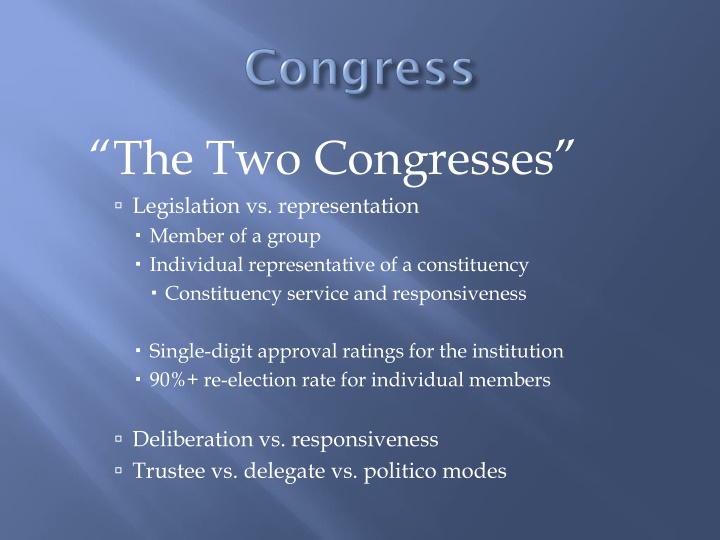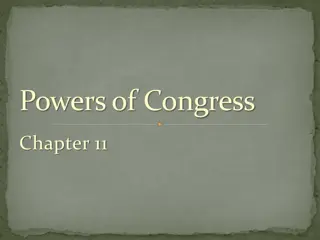
The Role of Bicameralism in the US Congress
Explore the significance of bicameralism in the United States Congress, the differences between the House and the Senate, the reasons behind the Connecticut Compromise, and how the system ensures representation and prevents tyranny. Understand the dynamics of legislation, representation, deliberation, and responsiveness in the two chambers of Congress.
Uploaded on | 3 Views
Download Presentation

Please find below an Image/Link to download the presentation.
The content on the website is provided AS IS for your information and personal use only. It may not be sold, licensed, or shared on other websites without obtaining consent from the author. If you encounter any issues during the download, it is possible that the publisher has removed the file from their server.
You are allowed to download the files provided on this website for personal or commercial use, subject to the condition that they are used lawfully. All files are the property of their respective owners.
The content on the website is provided AS IS for your information and personal use only. It may not be sold, licensed, or shared on other websites without obtaining consent from the author.
E N D
Presentation Transcript
The Two Congresses Legislation vs. representation Member of a group Individual representative of a constituency Constituency service and responsiveness Single-digit approval ratings for the institution 90%+ re-election rate for individual members Deliberation vs. responsiveness Trustee vs. delegate vs. politico modes
Why bicameralism? Connecticut Compromise Smaller states wanted equal representation, as had been the case under the Articles of Confederation (New Jersey Plan) Larger states wanted representation based on population more people, more reps. (Virginia Plan) The Compromise was one of each Senate = equal representation of states Wyoming has 2 Senators, California has 2 House = representation based on population Wyoming has 1 Rep., California has 53
Representativeness of population (House) Favors larger states Representativeness of states as equal partners (Senate) Favors smaller states The founders feared tyranny of government, but they also feared mob rule Both Houses have to pass the same bill in order for it to become law This also serves the purpose of checks and balances/separation of powers prevents the legislative branch from becoming too powerful in relation to the other two
House vs. Senate Representatives of the people vs. representatives of the states Popular election vs. state legislative election (originally) 17thAmendment (1913) made Senators popularly elected Two-year terms vs. six-year terms Responsiveness vs. deliberation
The Senate was supposed to be more deliberative and the House more responsive to public opinion Senate: Six-year terms Staggered terms mean that a popular uprising couldn t throw out the entire Senate at once, promotes stability House: Two-year terms Smaller number of Senators gives each one more individual power and allows for unlimited debate (protection of minority rights) The House is much more structured and runs according to majority rule
Connecticut: Class I and Class III Chris Murphy 2012, 2018 Richard Blumenthal 2016, 2022 Virginia: Class I and Class II Tim Kaine 2012, 2018 Mark Warner 2014, 2020 South Carolina: Class II and Class III Lindsey Graham 2014, 2020 Tim Scott 2016, 2022
Connecticut Virginia South Carolina 2012Murphy Kaine No election 2014No election Warner Graham 2016BlumenthalNo election Scott 2018Murphy Kaine No election 2020No election Warner Graham 2022BlumenthalNo election Scott
11 LARGEST STATES* 39 SMALLEST STATES* 2010 total population: 175,547,114 (56.4%) House seats: 250 (57.5%) Senate seats: 22 (22%) Electoral votes: 272 (50.6%) * California, Texas, New York, Florida, Illinois, Pennsylvania, Ohio, Michigan, North Carolina, Georgia, New Jersey. 2010 total population: 135,758,864 House seats: 185 Senate seats: 78 Electoral votes: 263 * Everyone else.
Senate: Minimum age of 30, citizen for 9 years House: Minimum age of 25, citizen for 7 years The Founders anticipated that the Senate would be the elder statesmen exercising greater judgment, while the House would be more responsive to the popular will Latin senex = old man This forms the root of both Senate and senile. Draw your own conclusions.
Demographically not very Wealthier, older, better educated than the population as a whole Whites are overrepresented and other racial groups are underrepresented There are now over 100 women in Congress for the first time in history. This is a big deal. (Why?) Why do we care what Congress looks like ? Descriptive representation vs. substantive representation
To what extent does Congress accurately reflect the will of the people? If a small, heavily Republican state like Wyoming has the same number of Senators as a large, heavily Democratic state like California, does this distort the popular will? What about the House? In some extreme cases, gerrymandering may cause the House to be unreflective of majority will






















